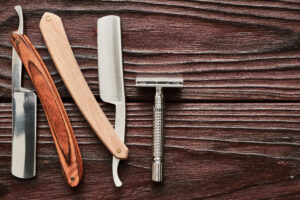Embarking on the journey of beard growth stages is a unique adventure.
The path to achieving that full, luscious beard can seem daunting at first glance. But fear not!
This journey separates the occasional shaver from the bearded gentleman. If you’re unsure about navigating through these stages, rest assured – we’ve got your back.
Tackling beard growth stages requires patience and dedication. It’s time to level up in your grooming game, gentlemen.
Table of Contents:
- Setting the Stage for Beard Growth
- The Early Days of Beard Growth
- Embracing Patchiness and Boosting Growth
- Grooming Your Growing Beard
- Decoding the Science of Beard Growth
- Conquering Common Challenges on Your Beard Growth Journey
- FAQs in Relation to Beard Growth Stages
- Conclusion
Setting the Stage for Beard Growth
Your journey to a full beard begins with understanding your hair follicles. These tiny powerhouses in your skin are responsible for producing each strand of facial hair, and they’re all unique – so don’t fret if you notice that your buddy’s beard grows faster than yours.
To start this adventure right, begin from a clean-shaven face. This allows an even playing field where every one of those hairs can grow at their own pace without any head-starts or late bloomers.
The Role Hair Follicles Play in Your Facial Hair Journey
Hair follicles aren’t just spectators on this ride; they’re driving it. They produce new cells which push older ones outwards to form what we know as ‘hair’. The speed at which these cells multiply directly influences how fast our beards fill out.
Another player in this game is testosterone – higher levels often correlate with increased rates of growth according to various studies.
Finding Your Own Path Towards Beard Mastery
Every man’s path towards his ultimate beard is different because everyone has their own set of active hair follicle soldiers readying themselves for battle against bare cheeks and chins. Some men may find stubble appearing after only several days while others might need weeks before seeing significant progress. But remember: It’s not about who gets there first but rather enjoying the journey.
- Nurture those budding strands through proper care routines such as regular washing and moisturizing using high-quality products designed specifically for beards.
Now that you’ve laid down some groundwork, let’s dive into dealing with common issues like itchiness due to its sudden appearance against previously shaven skin surface – coming up next.
Embark on the journey to beard mastery. Understand your unique hair follicles, start with a clean-shaven face and let each strand grow at its own pace. Remember, it’s not about speed but enjoying the process. #BeardGrowth #FacialHairJClick to Tweet
The Early Days of Beard Growth
As you embark on your beard growth journey, the first week presents noticeable changes. The emergence of stubble is a clear sign that facial hair transformation has begun.
Don’t fret if your initial growth patterns are uneven or different from others; remember, every man’s beard grows uniquely.
The Notorious Beard Itch
An all-too-common issue during this early phase is the infamous beard itch. This discomfort arises due to dead skin cells getting trapped in newly sprouting hairs and dryness caused by shaving off natural oils.
Fortunately, there are solutions available to address this issue. Regular applications of high-quality beard oil, for instance, can help soothe irritated skin and keep it moisturized.
Beyond using quality products like beard oil regularly, establishing an early grooming routine will pave the way for success throughout your entire bearding experience.
This routine should include washing with a gentle yet effective beard wash. Doing so helps remove any dirt or grime without stripping away essential oils needed for healthy hair growth.
- Tips For Dealing With Stubble And Itchiness:
- A regular application of top-notch DIY homemade beard oil mixture: A blend made up primarily of carrier oils (like jojoba) combined with some essential ones not only soothes itching but also promotes healthier follicles resulting in improved hair health overall.
- Maintain cleanliness: Keeping both face and hands clean at all times prevents bacterial infection, which could worsen itchiness.
- Patiently let it grow: Resist the urge to shave off irritating stubble – remember that most men find their discomfort usually subsides after about one week.
- As we venture into our next section, we’ll confront patchy areas head-on. Remember everyone’s experience differs – while some lucky few might have even spread right from day one, many encounter patches in their early stages.
Key Takeaway:
Embrace the early days of beard growth, even if it’s uneven or itchy. Use high-quality beard oil to soothe irritation and establish a grooming routine with gentle washes. DIY homemade oils can promote healthier follicles while cleanliness prevents infections. Patience is key – discomfort usually subsides after a week.
Embracing Patchiness and Boosting Growth
The early stages of beard growth can be a challenging time for many men. It’s not uncommon to see uneven or patchy patterns as your facial hair begins its journey towards becoming a full-grown, robust beard.
Testosterone has a major role in prompting the hair follicles to create denser and rougher hairs. However, this response isn’t uniform across all areas on your face, resulting in initial patchiness during the early phases of beard growth.
Foods That Promote Hair Growth
Your diet has a significant influence on how well you’re able to grow out that desired thick mane. Consuming protein-rich foods like lean meats, eggs, legumes, etc., helps boost both keratin synthesis – crucial for strong, healthy strands – and production levels of testosterone, which stimulates those vital hair follicles.
Vitamins A & E are also important players here, promoting sebum production, which naturally moisturizes the skin beneath your growing whiskers, aiding healthier development. Biotin, found abundantly within avocados, strengthens individual hairs, reducing the potential for breakage significantly.
Zinc too shouldn’t be overlooked, given that it aids DNA replication necessary for cell division, including those occurring within our hair follicles. Foods high in zinc include oysters, shellfish, beef, chickpeas, lentils, hemp seeds, flaxseeds, pumpkin seeds, eggs, wheat germ, tofu, mushrooms, spinach, cashews, quinoa, milk, cheese, yogurt, kefir, and kombucha, etc.
In essence, good grooming habits coupled with nutritious food, regular exercise, adequate sleep, and stress management will eventually help overcome any initial hurdles faced when growing out one’s facial fuzz. Remember patience, gentlemen – Rome wasn’t built in a day, nor will a perfect-looking beard appear overnight.
Grooming Your Growing Beard
Navigating the early stages of beard growth? Embrace patchiness and boost your mane with a protein-rich diet, vitamins A & E, biotin, and zinc. Remember: good grooming habits and patience are key. #BeardGrowth #MensGroomClick to Tweet
Grooming Your Growing Beard
As your facial hair begins to lengthen, reaching around a month’s worth of growth, it becomes crucial to consider grooming. This involves more than just trimming stray hairs – although that is an integral part of the process.
Essential Beard Care Products
The initial step in maintaining a well-groomed beard is investing in quality products. To ensure skin hydration and healthy hair growth, incorporating natural oils into your beard care regimen is highly recommended. A top-tier beard shampoo, for instance, will cleanse without stripping away natural oils, leaving you with softer and healthier-looking full-grown beards.
In addition to these essentials, another tool every man sporting a beard should have at his disposal is an excellent beard brush. Regular brushing helps distribute natural oils evenly across the length of your growing mane and removes any loose or dead hairs along the way.
You might also want to consider using dedicated trimmers for shaping purposes as they offer more control compared to regular razors when defining lines on your face.
The Art Of Trimming Stray Hairs
To maintain uniformity throughout all stages of growth requires mastering how to properly trim those pesky stray hairs that seem determined not to follow suit with the rest of their comrades. The right tools are critical here – professional-grade barber scissors provide precision cutting capabilities unmatched by standard household ones. With these in hand, effortlessly nip off unruly strands, causing unnecessary damage to the surrounding area. Always cut in the direction of the grain to avoid irritating the skin underneath.
Maintaining The Full-Grown Beards Look
If done correctly and consistently, a regular maintenance routine including proper washing, oil application, and brushing will result in a magnificent beard worthy of admiration and respect wherever you go. Slow and steady wins the race – resist the temptation to overdo it during early days of growth, and trust in nature’s process with a tailored care regimen. Patience is key here, trust the process, and let nature take its course, providing the necessary support and care regimen designed specifically for your beard’s needs.
Key Takeaway:
Embarking on your beard growth journey? Remember, it’s more than just letting hair grow. Invest in quality grooming products like essential oils and a top-tier beard shampoo to keep skin moisturized and promote healthy hair growth. Regular brushing is also crucial for distributing natural oils evenly across the length of your growing mane. Don’t forget professional-grade barber scissors for precision trimming.
Decoding the Science of Beard Growth
The science behind facial hair development isn’t as convoluted as it may appear. It’s all about understanding the natural hair growth cycle, which consists of three distinct phases: anagen phase (growing), catagen phase (resting), and telogen phase (hair loss).
An In-depth Look at Hair Growth Phases
First off, let’s debunk a common myth that shaving makes your beard grow back thicker. The truth? Shaving only gives hairs a blunt tip, making them feel coarser but doesn’t alter their thickness or speed.
A similar misconception involves certain vitamins boosting testosterone levels, thereby enhancing beard growth. While maintaining good nutrition can support healthy follicles indirectly, there isn’t concrete evidence showing a direct correlation between specific vitamin intake and increased testosterone production.
- Anagen Phase: This active growing period for each individual strand could last anywhere from two months to six years. You’ll notice consistent thickening and lengthening during this time.
- Catagen Phase: In this 2-3 week transitional period, no new cells are produced in the follicle bulb, causing hairs to detach from their blood supply before entering the telogen stage.
- Telogen Phase: Lasting approximately 100 days, old strands fall out, paving the way for new ones and initiating another round of the anagen phase once again. Some degree of hair loss here is normal – don’t panic.
Natural Factors Influencing Your Beard Journey
Your body naturally goes through these cycles without any external influence, but knowing how they work can explain why sometimes facial hair grows faster or slower than usual. For instance, stress, illness, poor nutrition, among other factors, may cause more hairs than usual to enter the telogen phase, leading to a temporary thinning appearance until recovery happens. After recovery, the majority of hairs will return back into the anagen mode, thereby restoring density gradually over time. This knowledge should empower you on your unique journey rather than
fuel unrealistic expectations.
Key Takeaway:
Understanding the three phases of hair growth – anagen, catagen, and telogen – is key to demystifying beard growth. Contrary to popular belief, shaving doesn’t increase thickness or speed; it just makes hairs feel coarser. Also, while good nutrition supports healthy follicles indirectly, there’s no proven link between specific vitamins and increased testosterone production for facial hair growth.
Conquering Common Challenges on Your Beard Growth Journey
Navigating the beard growth journey isn’t always a smooth ride. You may encounter obstacles like ingrown hairs and dry skin, but fear not. We’ve got your back with practical solutions to keep these issues at bay while maintaining an optimal washing routine that doesn’t strip away essential oils.
Tackling Grey Hairs in Your Mane
Spotting grey strands in your otherwise youthful-looking facial hair before they appear on the scalp is quite common among men. It’s nothing more than pigment cells responsible for hair color starting to retire early.
You have two options here: embrace this new silver fox status or consider dyeing them. If you choose coloring, ensure you use products specifically designed for beards as they are gentler compared to traditional hair dyes. Here’s how.
Battling Ingrown Hairs And Dry Skin Underneath The Beard
Ingrown hairs, those stubborn little nuisances can ruin any perfect beard day. They occur when trimmed or shaved strands curl back into their follicle instead of growing outward. To prevent this annoyance, incorporate regular exfoliation using a gentle scrub suitable for the face; it helps eliminate dead skin cells which could block pores leading to ingrowns.
Dryness underneath your luscious locks can also throw spanners during your beard growth expedition. Regularly moisturizing under the mane keeps dryness at bay; opt-in hydrating serums or lotions specially formulated keeping the unique needs of bearded men in mind.
Establishing A Healthy Washing Routine For Facial Hair
An effective washing routine makes all the difference between well-groomed versus scruffy-looking facial fuzz.
Your instinct might suggest reaching out for a standard shampoo, but hold up – most shampoos contain harsh chemicals stripping off vital natural oils, leaving both the skin and strands parched. Instead, go for sulfate-free washes explicitly crafted considering the unique requirements male whiskers offer.
Key Takeaway:
Beard growth comes with challenges like grey hairs, ingrown hairs and dry skin. Embrace your greys or use beard-specific dyes; prevent ingrowns through regular exfoliation; combat dryness with special serums or lotions. Ditch standard shampoos for sulfate-free alternatives to maintain essential oils.
FAQs in Relation to Beard Growth Stages
How long is a beard growth cycle?
The length of a beard growth cycle varies among individuals but typically lasts around two to six months.
At what age is a beard fully developed?
A man’s beard usually reaches its full development between the ages of 25 and 35, although this can vary widely based on genetics and hormones.
What does a two-month beard look like?
A two-month-old beard often shows significant coverage with hairs measuring about one inch in length. However, individual results may differ due to variations in hair growth rates.
In what order does facial hair grow?
Facial hair generally starts growing at the upper lip area during puberty, followed by the cheeks, chin, and neck region. The pattern can vary depending on genetic factors.
Conclusion
From the initial stubble to a full-grown beard, every stage of your facial hair journey is unique.
We’ve walked you through how your hair follicles set the stage for growth and tackled common issues like itchiness and patchiness.
You now understand why patience is key in dealing with early stages of growth and that grooming isn’t just about looking good – it’s crucial for healthy growth too!
Unraveling the science behind beard growth has debunked some myths, shedding light on anagen, catagen, and telogen phases.
We also covered ways to deal with ingrown hairs or dry skin under your luscious locks while maintaining natural oils.
If this deep dive into beard growth stages has sparked curiosity about enhancing other aspects of life as well – we’re here for you! At OneUpMan.com we are dedicated to helping guys get ahead in life, love, lifestyle, and grooming gear. Whether it’s leveling up their wardrobe or mastering dating etiquette – our aim is to help men become better versions of themselves.




